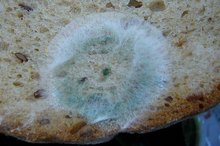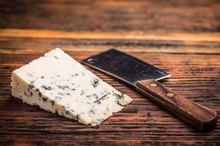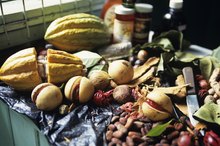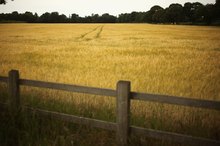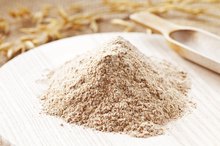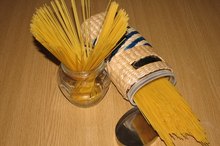What Signs Should You Look for When Mold Is Forming on Bread?
While it may seem gross to some people, mold is a natural organism found just about everywhere on Earth and one that is vital to the life cycle. Much of the time it is not harmful to humans. However, when mold grows on food, it can release mycotoxins that are poisonous to humans, and most moldy foods, particularly moldy breads, should be avoided. There are a few signs to look for if you suspect that bread may be moldy.
If you are experiencing serious medical symptoms, seek emergency treatment immediately.
Appearance
This is one of the most important ways to identify bread that may be contaminated by mold. Many different types of mold can form on breads, each with a distinct appearance and color. However, it doesn't matter what form of mold has formed on bread: none of these molds are safe to eat. If the surface of bread is altered by small white spots, light green or yellow furry sections or even dark or blackened areas, it's best to throw the bread out rather than to risk getting sick.
- This is one of the most important ways to identify bread that may be contaminated by mold.
- Many different types of mold can form on breads, each with a distinct appearance and color.
Environment
Mold on Wheat Bread vs. White Bread
Learn More
Even if bread has not reached its expiration date and has no visible mold on its surface, mold can still penetrate beneath the visible areas of bread. This is true of any porous food. Thus, those who are concerned about whether or not bread may be contaminated by mold should consider the environment in which bread has been stored. If it is excessively humid or moist, the bread could start to grow mold well before it is technically expired. If bread has been stored in such an environment for days, it is best to discard it and to store future loaves in a cool, dry place.
- Even if bread has not reached its expiration date and has no visible mold on its surface, mold can still penetrate beneath the visible areas of bread.
- Thus, those who are concerned about whether or not bread may be contaminated by mold should consider the environment in which bread has been stored.
Bread Type
Not all breads are as susceptible to mold growth as others 2. Generally, the more water content a bread has, the more quickly it will mold 3. This means that a bread like oat bran bread, which typically contains an average of 47% water, will mold in most instances more quickly than Navajo fry bread, which has a water concentration of only 26%. If a bread seems particularly moist, then use more caution with that loaf as opposed to bread that seems very dry or has been toasted.
To Smell or Not To Smell
How Does Mold Affect Food?
Learn More
Some people having trouble identifying mold on the surface of bread may be tempted to sniff the bread to see if it smells like it has gone bad. This, however, is never a good idea. Smelling potentially moldy foods can cause mold spores to be drawn into the respiratory system, which can cause respiratory problems or other complications, particularly in those with weakened immune systems. When in doubt it is better to carefully dispose of the bread rather than risking contact with mold and illness.
- Some people having trouble identifying mold on the surface of bread may be tempted to sniff the bread to see if it smells like it has gone bad.
- Smelling potentially moldy foods can cause mold spores to be drawn into the respiratory system, which can cause respiratory problems or other complications, particularly in those with weakened immune systems.
Related Articles
References
- MadSci FAQ: Bread Molds and Other Moldy Foodstuffs
- Web MD: The Basics of Mold Allergies
- MadSci: Which Type of Bread Molds the Fastest?
- Amirhosein Ghaffarianhoseini, Husam AlWaer, Hossein Omrany, Ali Ghaffarianhoseini, Chaham Alalouch, Derek Clements-Croome & John Tookey (2018) Sick building syndrome: are we doing enough?. Architectural Science Review,61:3, 99-121.
- American College of Allergy, Asthma & Immunology. Mold Allergy. Reviewed April 23, 2018.
- Centers for Disease Control and Prevention. Fungal Diseases. Reviewed May 6, 2019.
- Centers for Disease Control and Prevention. Mold. Basic Facts. Reviewed December 20, 2017
- Asthma and Allergy Foundation of America. Mold Allergy. Reviewed October 2015.
- Centers for Disease Control and Prevention. Molds in the Environment. Rreviewed December 20, 2017.
- Asthma and Allergy Foundation of America, Mold Allergy
- Centers for Disease Control and Prevention (CDC), Mold, Basic Facts
- Rudert A, Portnoy J.Mold allergy: is it real and what do we do about it?Expert Rev Clin Immunol. 2017 Aug;13(8):823-835. doi: 10.1080/1744666X.2017.1324298. Epub 2017 May 17.
Writer Bio
Brianna has been writing professionally since 2009. She has a Bachelor of Fine Arts degree and is excited to be part of a community that contributes to the free sharing of information and ideas.
